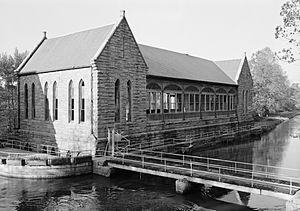Wilfred Emory Cutshaw facts for kids
Quick facts for kids
Wilfred Emory Cutshaw
|
|
|---|---|
| Born | January 25, 1838 Harpers Ferry, Virginia |
| Died | December 19, 1907 (aged 69) Richmond, Virginia |
| Allegiance | |
| Service/ |
|
| Years of service | 1861-1865 |
| Rank | |
| Commands held | |
| Battles/wars | First Battle of Winchester Valley Campaign of 1862 Valley Campaigns of 1864 Battle of Sailor's Creek |
Wilfred Emory Cutshaw (born January 25, 1838 – died December 19, 1907) was an American engineer and soldier. He graduated from the Virginia Military Institute and became a lieutenant colonel in the Confederate Army during the American Civil War. After the war, he helped rebuild Richmond, Virginia, serving as the city engineer for 34 years.
Contents
Early Life and Education
Wilfred Emory Cutshaw was born in Harpers Ferry, which is now in West Virginia. His parents were George W. Cutshaw and Martha J. Moxley. He was taught at home and at a local school. Young Cutshaw studied civil and military engineering. He graduated from the Virginia Military Institute (VMI) in 1858. After VMI, he taught for a short time in Loudoun County. Then, he took a job at the Hampton Academy in Hampton, Virginia. This academy used the VMI teaching style to train young Virginians as military officers.
Service in the American Civil War
When Virginia decided to leave the United States in April 1861, Cutshaw left his teaching job. He joined the Confederate Army as a lieutenant. He first worked as an assistant to his former principal, now Confederate Major John B. Cary.
Cutshaw quickly moved up in rank and gained a lot of experience in battles. The Hampton Military Academy never reopened after the war. The city of Hampton was burned by Confederate General John B. Magruder on August 7, 1862.
Early Battles and Promotions
Cutshaw fought under General Magruder in the Peninsula area during the summer of 1861. He was then promoted to captain. He led an artillery group in General Stonewall Jackson’s brigade during the Valley Campaign of 1862.
In 1862, Cutshaw was promoted to captain of artillery. However, during the First Battle of Winchester, he was shot in the knee. Federal forces captured him. After a prisoner exchange, doctors said Cutshaw was too injured to serve. But he was still promoted to major. He briefly returned to teaching at the Virginia Military Institute.
Later Service and Injuries
Even though he was still injured, Cutshaw rejoined the army in 1863. In February 1865, he received his final promotion to lieutenant colonel.
Cutshaw served under General Jubal Early during the Valley Campaigns of 1864. He missed the Third Battle of Winchester because he was on a mission behind enemy lines in West Virginia. As the Confederate defeat became clear in 1865, he was badly wounded in the leg. This happened during the Battle of Sailor's Creek, just three days before General Robert E. Lee surrendered at Appomattox. Doctors saved Cutshaw's life, but they had to remove his leg.
Richmond's City Engineer
After the war, from 1865 to 1873, Cutshaw worked several jobs. He was a professor at the Virginia Military Institute. He also assisted Charles P. Stone, an engineer at the Dover Coal and Iron Company.
When Richmond's city engineer, Charles H. Dimmock, died in 1873, former General Robert E. Lee suggested Cutshaw as his replacement. Richmond was still badly damaged from the war. For the next thirty years, Cutshaw worked hard to rebuild the city's public systems.
Major Projects and City Beautification
He led many projects during his time as city engineer. One big project was the waterworks system. This system pumped water from the James River and Kanawha Canal into the Byrd Park Reservoir. He also strongly supported creating public parks and spaces for people to enjoy.
In 1879, Cutshaw traveled to visit parks in the northern United States and Europe. He used what he learned to plan and design public spaces in Richmond. He brought the "City Beautiful" idea to Richmond. This idea focused on making cities more beautiful and grand.
Some of Cutshaw's important projects include:
- Monroe Park
- The Boulevard
- A city nursery that grew over 50,000 trees for the city
- A public water reservoir in Byrd Park
- Turning hills into usable spaces and parks, like Libby, Gamble's, and Chimborazo Hills.
Cutshaw managed projects of all sizes, often with many uses. He oversaw the city's street layout and water system. He also supervised important building projects. Many of these buildings were in the popular Gothic Revival style. They were built from local granite and are now on the National Register of Historic Places. These include the Old City Hall, finished in 1886, and the Byrd Park Pump House from 1883. The city's wealthy citizens would arrive by boat to attend social events on the pump house's open-air dance floor. Other public buildings built during Cutshaw's time include fire stations, markets, schools, and armories.
Later Life and Legacy
Cutshaw outlived two wives and did not have any children. He first married E.S. Norfleet in 1876, but she died less than a year later. In 1890, he married M.W. Morton, who also died within a year. When he passed away in 1907, he was buried at Richmond's Hollywood Cemetery. Many other former Confederate soldiers and city leaders are buried there.
Cutshaw's work as an engineer and his contributions to society were recognized during his lifetime. He was elected a member of the American Society of Civil Engineers in 1891. He was also active in many groups, including:
- Confederate Veterans organizations
- The Royal Arcanum
- Southern Historical Society
- Virginia Historical Society
- Richmond YMCA
He also served as president of the Virginia Military Institute Alumni. A plaque inside Richmond's Old City Hall honors his work. In 2015, the Virginia Department of Historic Resources placed a sign in Byrd Park to remember Cutshaw's contributions to the city.


